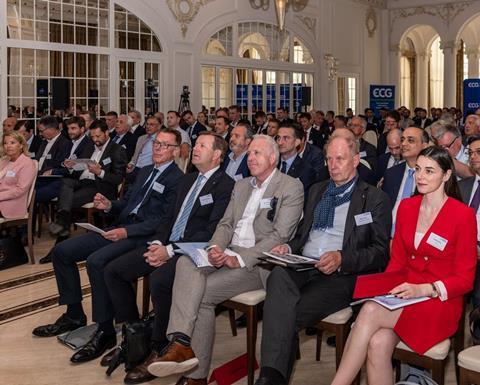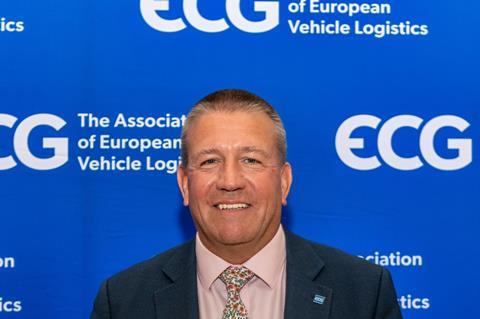At this year’s General Assembly and Spring Congress for the Association for European Vehicle Logistics (ECG), members from the top outbound logistics providers and their OEM customers discussed the current disruption affecting the business and the creative solutions used to deal with it
Disruption has become standard in vehicle logistics as the sector enters its third year of seemingly constant turmoil. From the Covid crisis to the consequent impact of the semiconductor shortage, and now the ongoing war in Ukraine – it has never been more pressing for carmakers to cooperate with their transport and logistics providers to resolve the problems caused by the disruption and future-proof the outbound supply chain.

The Association for European Vehicle Logistics (ECG) held its 27th General Assembly and Spring Congress in Malaga, Spain between 12-13 May. The organisation represents around 85% of Europe’s finished vehicle logistics providers, and several top experts and members from across the sector came together to discuss coping strategies amidst extraordinary global circumstances.
At the congress, ECG members drew attention to the specific problems facing the various parts of the business and many had gloomy descriptions of the logistics landscape. Lack of overall confidence in future volumes is causing a downwards trend in planned investments.
Operators’ sentiment about the sector is marked by pessimism. According to the ECG’s most recent quarterly Cost and Confidence survey, less than 20% of respondents feel optimistic about business prospects.
“Optimism is certainly not encouraged by contracts that are not fit for purpose in such rapidly changing environments,” said ECG’s executive director, Mike Sturgeon.
Multiple headwinds
There are several pressures currently adding to the gloom. Inflation is casting a long shadow across Europe. According to Eurostat, the European Commission’s statistics agency, inflation across the EU as an average rose 7.5% at the end of March, and forecasts predict this will hit double figures as an average across the region this year. That figure is driven up by the higher inflation in eastern Europe.
Transport providers are responding with more flexible contracts.
Namrita Chow, an analyst for Automotive Logistics, explained how Girteka Logistics is expanding despite rising costs, with 2,000 new Volvo FH trucks being delivered in 2022. Girteka has agreements with customers that take price fluctuations into consideration and is revising existing contracts to include floating prices.
Added to inflationary issues there is an ongoing driver shortage in the sector, part of wider labour shortages and rising labour costs that are affecting the logistics industry. This also applies to compound and technical workshop operatives.
ECG’s Cost and Confidence survey revealed that the number of truck operators planning to invest in trucks and drivers in the next six months has fallen to around 30%. Drivers have been leaving the industry over the last two years because of the crisis and the collapse in volumes. Ukrainian drivers have also flocked home to support the war effort. These combined problems have pushed up waiting times for the delivery of vehicles to the customer.

There are also cost increases associated with replacing and maintaining critical assets, such as ships, barges, rail wagons and road transporters.
“Operators cannot move vehicles without assets. The car industry is facing an extremely high risk of losing its suppliers,” warned ECG president, Wolfgang Göbel.
On top of this, uncertainty surrounding the conflict in Ukraine is causing material and component prices to spike, while also driving up operating costs and fuel prices, the latter being the main concern for those in the finished vehicle sector, according to a recent survey carried out by RPM and Automotive Logistics.
Höegh Autoliners, one of the world’s largest providers of maritime finished vehicle services, has been monitoring the situation in Ukraine, all the while complying with international sanctions. The company said problems with sourcing essential materials for vehicle production because of the conflict had encouraged further communication with OEM customers that were impacted.
China’s zero-Covid policy
Another problem affecting the sector is the renewed Covid lockdown in Shanghai and China’s zero-Covid policy, which could now spread to other major manufacturing locations in China. The impact on production and logistics has been damaging. Parts are languishing in supply chain bottlenecks and exacerbating the volatility in vehicle output, and it is likely to do so for the coming months. Vessel congestion off the coast of China is still at record levels.
Justin Cox, director of global production forecast at automotive analyst LMC Automotive, said “all bets are off” when it comes to Omicron variant of Covid. He stressed that Covid-related backlogs and disruptions remain an ongoing concern.

The automotive industry relies on China for parts supply, more so in an era of EV growth because most battery suppliers (and semiconductor producers) are based there and in wider Asia. However, companies are increasingly looking for alternative sourcing locations away from China and localising production.
Even those carmakers and logistics partners that have recovered have had to reorient business models significantly, said Cox. They are now mainly focusing on high-margin products and fast-selling vehicles, such as sports cars. However, even this apparent quick-fix is under threat as because of inflation.
According to Cox’s medium-term score card, most companies will likely not recover to pre-pandemic production levels this year. Others, such as GM, Honda and Ford, are not expected to see a total return until 2026.
Manufacturers more widely are increasingly looking to adapt existing infrastructure to save costs instead of investing in greenfield developments.
Digital tools for savings
At the same time logistics providers are looking at greater efficiency through digital tools to save costs in the movement of vehicles to market.
Matt Holmes, director of insurance claims specialist Sevatas, focused on digital vehicle handovers (DVH) as a potential improvement of the logistics process in the face of global upheaval. This technology records vehicle quality at gate release and handover points in the delivery process.

Blockchain technology combined with global inspection databases are the basis of data collection in DVHs and accumulate information from factory to dealer to ensure the quality of cars being rolled out, replacing reliance on data silos.
Alongside this, Holmes called for a legal protocol to be formed to better understand digital handovers.
The ECG has been supporting the digitalisation of the supply chain with reciprocal support from Sevatas to engineer solutions to improve data flows.
The creativity and innovation on display demonstrate how involved logistics leaders are in trying to circumvent ongoing problems, and data transparency has now taken centre stage in this process.

Looking for optimism `
Innovation can be difficult to execute for immediate gains, especially in networks and processes that have become entrenched in the automotive industry over many years. However, making better use of data to establish standards in sustainabililty is one area where progress is being made.
The ECG is working with Germany’s automotive association, the VDA, and with Odette, which helps to develop standards to deal with supply chain challenges in the automotive industry. Together they are working on guidelines to cut emissions in inbound and outbound logistics.
VDA representative and senior manager of green logistics at VW, Daniele Saba, talked about standardising emissions reporting in the automotive sector.
He said the logistics sector is becoming a focus area for sustainability. Accurate reporting and the development of more effective ways of reporting carbon output will be essential to reaching net-zero by 2030.
That accuracy depends on the participation of all stakeholders, according to Saba, and important in achieving a high quality of data that can be used to establish the guidelines, Between them, the VDA, ECG and Odette aim to deliver a standard methodology in emissions reporting by Q1 2023.
OEMs and suppliers will have to define requirements for basic reporting needs, said Saba. Logistics providers will also have to address any gaps in the information they gather on emissions through their daily operations.
OEMs and suppliers will have no choice but to adapt to international and domestic laws in an array of areas, from sustainability and safety in shipping to politically driven localisation.
The multi-pronged push to reach international targets has caused this corresponding lurch to acquire accurate data and increase transparency which, in turn, will make responding to changes more manageable. Difficulty in responding to crises won’t always be the rule in logistics.
While there is undoubtedly an unease in automotive logistics at the moment, the atmosphere of creativity evident at the ECG provided a much-needed positive counterweight.

























![Global[1]](https://d3n5uof8vony13.cloudfront.net/Pictures/web/a/d/s/global1_726550.svgz)













No comments yet